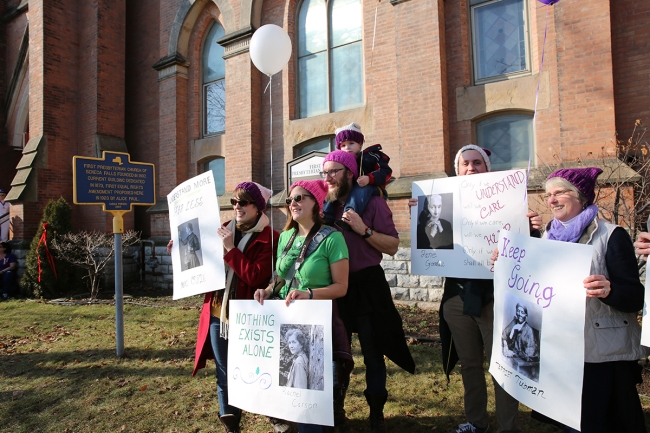You have /5 articles left.
Sign up for a free account or log in.

Women March in Seneca Falls 2017
Kathy Collins Photography
It has been said over and over again: upstate New York -- especially Seneca Falls, N.Y., and its surrounds -- has given rise to social movements central to American history and life. Saturday, Jan. 21, was good reminder of just how the women’s history of Seneca Falls can still call us.
Never mind the beauty of the Finger Lakes, the growing wine industry and the organic farming the area is enjoying, or the region’s nearby wildlife refuge. What brought more than 10,000 people (doubling, and then some, the town’s size) to Women March in Seneca Falls 2017 was its women’s rights, abolitionist and Native American history.
Garbed in suffrage colors, marchers of all genders raised banners festooned with messages on gendered human rights, immigration, religious freedom, the environment, racial justice, health care and more -- a call to action one might well term a moment of great channeling.
Most speakers (and there were more than 30) gestured in one way or another to many women history makers, authorizing women’s place over the centuries as actors and agents of democracy, liberation and charting the future. This was not the old add-and-stir approach to women’s history. History was being relayed to stage the future, to renew commitments and to conceptualize liberty and democracy once more. It was a moment when one could actually see, hear and feel the movement of history.
The march drew directly on the symbolism of Seneca Falls. Marchers set off from the Women’s Rights National Historical Park and headed to the First Presbyterian Church. There, in 1923, Alice Paul introduced the Lucretia Mott Amendment -- now known as the yet-to-be-ratified Equal Rights Amendment. En route, we walked within steps of where, in 1977, Maya Angelou’s Declaration of American Women (entitled “To Form a More Perfect Union” and resonant with themes of its sister 1848 declaration) was read and a torch lit to send relay runners on their freedom run from Seneca Falls to Houston to inaugurate the first and largest National Women’s Conference.
Reference was made to the area’s 1980s Women’s Encampment for a Future of Peace and Justice, protesting nuclear weaponry, housed nearby at what was then the Seneca Army Depot. Convening the assembled marchers were leaders from Oneida, Akwesasne and Mohawk nations, reminding one and all that suffrage is beholden to Iroquois women -- as was said often that day -- because care of the land was and is sacred to their longstanding participatory democracy. To this was added a roster of movement leaders, invoked throughout the event, from Frederick Douglass, one of the signers of the declaration, on through to Harriet Tubman, Susan B. Anthony, Elizabeth Cady Stanton, Matilda Joslyn Gage and more.
Opening the rally, local businesswoman Becky Bly recalled the 300 people who gathered at the adjacent Wesleyan Chapel in 1848 on the historic occasion of what is often deemed the first women’s rights convention, culminating, as it did, in a reading of its visionary document, the Declaration of Sentiments. Seneca Falls, she noted that day, was one of over 600 sister marches taking place throughout the United States and around the globe. “Welcome to Seneca Falls,” she said. “Welcome home.”
Staging the Future
At the time, I heard Bly’s “welcome home” as welcome to the movement -- specifically, the Seneca Falls women’s movement as home. But her greeting stayed with me. What is home in today’s changed world? Can a movement from 19th-century Seneca Falls offer more of a sense of home than the physical location of a town, city or country? Or was there more to her welcome, with its echoes in greetings at other feminist gatherings and its resonance with Virginia Woolf’s 1938 anti-fascist tract: “As a woman, I have no country. As a woman I want no country. As a woman my country is the whole world.”
For those of us who teach, and especially those who teach courses in women’s and gender studies, the question is key, perhaps even foundational: Is the women’s and gender movement home, and, if so, does that underscore the significance and importance of teaching about Seneca Falls? Does the ribbon of women’s movement history roll out across time and space from Seneca Falls? Is this the place where it all happened, as some like to say? Does this place teach us the function of myth and its mythmaking power for social change, as Lisa Tetrault, associate professor of history at the University of Wisconsin at Madison, ventures in her history of Seneca Falls? Or do the questions posed this way open up the history of women’s movements as a contest over meaning, ritual and re-enactments for feminist futures?
Surely, this is, in part, what Saturday Night Live was driving at with its recent sketch featuring millennials conjuring the ghost of Susan B. Anthony at the Susan B. Anthony House in Rochester, N.Y., only to quickly lose interest in her presence. Surely, this also means (re)considering how, just a few months earlier, on Nov. 8, 2016, people lined up for hours on end to pay tribute to this suffragist, abolitionist and women’s rights campaigner on a day they imagined would be historic in its election of the first woman president of America. The SNL millennials’ short attention span disclosed their faint and passing interest in the history of the women’s movement until Susan B. Anthony uttered her opposition to abortion.
The point was not lost on college students watching this clip in my class. What did they know -- really know -- of women’s history? And what difference, if any, does that knowing effect in the world today? How does millennials’ seemingly fleeting or ambivalent relation to feminist history tell us more about the failures of romanticizing the past and about our own inability to see or imagine how they take up feminist history’s possibilities to act in the world?
One other message in SNL’s short satire really hit home. Women’s rights legacies are not simply and only about upholding the past as some quaint object of interest: see my desk, hold a pair of my shoes and touch the stove where I cooked my meals. Rather, historical moments such as the women’s rights movement in upstate New York need to be thought about as having the capacity to stage the future over and over, a future we continue to grapple with, worry over and teach about. To visit historic sites in Seneca Falls, Rochester, Auburn and Fayetteville, N.Y., to name a few, is to delve more, not less, into women’s history and to do so as neither sound bite on how women got to where they are (the use of history as a progressive narrative) nor as an all-too-brief mention. It is to embark on a history of women’s history as American history front and center -- as a course of action, of history as what engenders actions -- what we revisit to open up fields of possibilities of what could yet be.
The case can thus be made that to teach about Seneca Falls is to teach about participatory democracy; to engage with the debates and struggles among writers and leaders in the moment of their taking shape around gender, race, democracy, rights, enfranchisement and liberation; to stage the future of women’s and gender movements around racial justice and equality. It is this very idea of staging the future that is often left out of teaching women’s history or feminist theory.
By that I mean women’s history is often taught, on the one hand, as a progressive narrative and, on the other, as critical inquiry into the missing, marginalized or misrepresented. Such historiographical leanings offer but two registers on which to engage history. They keep us looking to the past, mired in certain frameworks. Other registers help to direct us to how we occupy history even as it is “out of time” -- for instance, how we occupy the history of Seneca Falls in the present as one calls for new ways of being and living.
This is not the old story of know your history so you do not repeat the past. As philosopher Elizabeth Grosz reminds us, history “is larger than the present … is the possibility of resistance to the present’s imposed values … futures that resist and transform.” Or, to use historian and performance theorist May Farnsworth’s idea of “feminist rehearsals,” the act of invoking forms of history in a performance -- such as, one could argue, marches and rallies -- is to prepare a community to make change, to bring into being new worlds for collective action, and thus the reconceptualizing of key terms such as gender, race, class and liberty, freedom and justice.
These ways of understanding history, of teaching the work of history in places such as Seneca Falls, critically engage temporal modalities and scales of movement histories. They prompt us to adapt Emily Apter’s question of what is women’s time in theory to history: What is women’s time in history? The march in this historical place of abolition and the women’s movement raised before all of us the question of time, the matter of temporal scales and of periodicity as forces to engage to remake the world.
Those suffrage colors revamped as pussy hats, glittery balloons bedecked with the handwritten names of revolutionary leaders, posters morphing slogans from yesteryear to today, pastiches of participatory democracy over social media -- in person and streamed live via Facebook and a Jumbotron -- all instruct us on how anachronisms can summon us to engage anew with the politics of periodicity in movement history: women’s and other movements for change. Cross-cutting time and geography, these “untimely” things, as Grosz refers to them, remind us of “what has not used up its pastness,” having potential for the future.
These are at least some of the reasons teaching about place may encourage students and ourselves to take a more gritty look at history, to ask, in this moment of a great channeling, what does it mean historically to study those who sought to interrogate and to build again a place one might call home, to remake the world. Current-day strife reignites this question of historiography, feminisms and movements for change. This kind of questioning quite possibly places women’s and other movement histories at the heart of liberal arts education.








